

Sd.Kfz.171 Panther A
Late Production
Dragon Premium Edition Kit No. 6358
1:35 Scale
Review by Terry Ashley




Dragon continue to re-issue previous kits in the Premium Edition range with updated parts and additional metal parts with this latest being the Panther Ausf.A Late Production which is based in their original Ausf.A Late kit #6168 and as this is basically a sound model of the late Ausf.A it bodes well for this new kit.
To hopefully clear up any confusion about what is actually in the kit after the various advertisements that precede each new Dragon kit release I can advise there is only one new plastic part, the glacis MG ball mounting in the kit with all other parts coming from either the previous Ausf.A kit #6168, the recent Premium Ausf.D kit #6299 or the Ausf.G Smart kit #6268 with the only other new parts being the metal barrel and a few additional etched parts on the fret from the Ausf.D kit.
Some of the parts have been tweaked with better detail such as casting texture on the mantlet and wood grain on the jack block with the glacis modified to take the new MG housing but other than that all the parts are the same as with the kits mentioned.
Unfortunately Dragon have again chosen to recycle those ridicules photo type instructions which are not only hard to follow but tell you to use the completely wrong parts especially on the rear of the turret but thankfully these instructions were short lived but still haunt these Panther kits.
Other problems with the instructions is the photos show one part in one photo and another in the next, the drive sprockets being an example where it shows to fit the correct Ausf.A hub cap and in the next photo shows the Ausf.D hub cap fitted so you really do have be on your guard using these.
As there are the sprues from the Ausf.D and Ausf.G kits included you get quite a few parts not used to fill the spares box but as mentioned the instructions tell you to use the Ausf.D rear turret wall and escape hatch instead of the correct Ausf.A parts but thankfully these are included so the kit can be built correctly but it’s a big trap for the unwary.
As mentioned the kit represents a late model Ausf.A and does this quite well with just a few small areas to watch such as the rear turret wall (the instructions fault not the kit), the front crew hatches lack the two locks fitted to later hatches and the hull side track pin return plate should be the later rectangular type and not the earlier type provided which is easy enough the build out of plastic card.
The biggest issue is all these type Panthers should have Zimmerit paste and you will have to add this either using aftermarket resin sets from ATAK or Cavilier or with putty or filler and texturing this yourself.
The kit:
This consists of 406 parts in light grey plastic but of these 160 are consigned
to the spares box plus the metal barrel, 10 metal side Schuerzen plates and
a large etched fret as well as 16 clear plastic parts and a bag of ‘magic
tracks’.
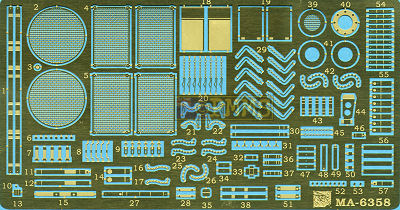

The standard of moulding is excellent with the only cleanup needed being the usual fine moulding seams on the parts and the many small plastic ‘nodes’ on the parts which help keep pin marks virtually non existent but do require care when removing from the smaller parts. The extensive use of slide moulds results in some excellent details on many of the parts from the larger (mantlets) to the very small making for a very detailed model out of the box but as with any kit there are areas that can do with a little attention.
Dimensionally the kit matches available 1:35 plans in the Panzer Tracts No. 5-2 Panther A book perfectly with any discrepancies being so minor as not worth mentioning.
Lower Hull:
The lower hull tub is the modified tub from the Ausf.D kit with separate axle
arms that include the three different styles fitted to the first three stations
as depicted in the Ausf.D and Ausf.G kits with separate bump stops and the
rear track pin return plate but as mentioned this should be the later rectangular
type and not the earlier type provided in the kit (part M18).
Just note on the second axle arm there is a raised seam down the middle which should be there so don’t be tempted to remove this like the fine moulding seams on the other arms.

At the front are separate final drive mountings with nice bolt head and weld bead details and also include the two fender attachment bolts on the front of the towing eye so be careful not to remove these during cleanup as the sprue attachment point is right next to the bolts. The final drives themselves have the separate small roller wheel added with the drive sprockets having the later 32 bolt heads but only on the outside of the outer sprocket but on both sides of the inner sprockets with a separate hub cap of the correct style for the Ausf.A.
The rubber tyred road wheels are from the Ausf.G kit with the correct 24 rim bolts for the later Ausf.A and the axle arms from the Ausf.D kit as mentioned but also included on the sprues are the full torsion bars that came with the Ausf.G kit which are not used here and can be consigned to the spares box. If you wanted to add these to the hull it would be easy to cut off the axle arms and position these inside the hull but I wouldn’t try drilling out the hull side locating holes and using the full axles/torsion bars as the hull is not designed for this and other issues will arise.
At the back is a four part idler wheel that assembles into a nice representation of the 600mm real thing but you may want to thin the ribs a little and add the small grease nipples for a better appearance and these are attached to the separate axles that allow you to alter the track tension so it’s best not to glue the axle in place until adding the tracks.
The rear hull plate fits precisely to the hull tub with separate central inspection hatch that includes the towing shackle for the later Ausf.A with the exhaust pipes nicely depicted with the ends slightly hollowed out but you may want to drill these further for a better appearance. Also provided are plastic or etched attachment brackets for the exhausts to use as you see fit.
A seven piece jack is provided along with the two storage boxes which have etched top sections plus the convoy in the correct position with plastic tow shackles.
Tracks:
Included in the kit are separate link “magic track” with the late
style track with the ice cleats and the detail on the tracks is very well done
especially the open guide horns with excellent detail added using slide moulds.
The links are designed to simply be glued together and are not workable but the kit tracks should be adequate for most applications with additional track links with separate guide teeth to use around the drive sprockets as the ‘magic track’ links have guide teeth holes too small to fit the sprockets properly but you won’t notice this on the normal track runs.
The other thing to note is there are actually left and right handed tracks on the Panther with different end pins on each but Dragon only give you the right handed track which means you don’t get this important Panther track detail and while this may not be an issue for some it should be taken into account for true accuracy.
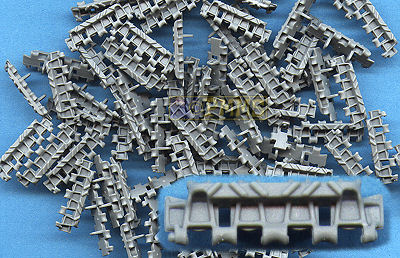
Upper Hull:
This again is the same as in the previous kit with separate glacis, crew hatches
and front periscopes, engine hatch and intake covers and open intake grills
as well as separate underside overhang sponson fillers to eliminate any see-though
look.
The hull has a slight ‘orange peel’ surface effect and nicely represented weld seams around the numerous panel joins as well as the engraved bolt heads around the crew hatch panel, engine deck and around the turret ring for a good representation of the Ausf.A hull.
On the glacis the driver’s visor port can be assembled open of closed while the machine gun housing has been redesigned as a single piece that fits into the redesigned position on the glacis and includes the full hull MG34 from the Ausf.G kit to add more detail to this area. One item missing is the MG port plug which is secured with thin chain to the hull top and again this can be added for a more complete finish.
The front periscopes are in clear plastic but the photo instructions still show the solid plastic items so watch this with separate outer periscope covers plus the central ventilator cover and later style asymmetrical barrel travel lock. This has the securing chain links in multi-part etchings where you sandwich six etched parts together to form the link chain and this does look much better than the plastic chain included with the travel lock.
The crew hatches have interior details and also have the outside grab handles in the correct corner position but there are raised locating marks for the early central location left over from the Ausf.D kit and these should be carefully removed. The two key locks included on the later hatches are missing which you may want to add?
The front fenders are included on the underside sponson filler but the hinged fender extensions are not included in the kit but as these were commonly removed from operational vehicles this omission is not really that much of an issue unless you wanted to make a factory fresh Panther.
Along the hull sides are the tool brackets with the tools having etched clips and brackets provided as well as bare tools to use with these as plus the “normal” tools with moulded on tool clips for a quick build. The cleaning rod contained also has etched securing strips and the rear mounted spare track brackets also have etched clips for a nice detailed appearance.
The engine deck layout is correct for the later Ausf.A with separate intake grills and central engine bay hatch which has additional parts for the intake covers as well as etched screens provided for the radiator intakes and smaller ventilation opening.
Added along the sides are the metal Schuerzen plates provided and you can easily leave one or more off to show battle damage if you wish.
The Turret:
The basic turret shell with separate lower ring is from the previous Ausf.A
kit slightly modified by deleting the side pistol ports and adding the roof
mounted Nahverteidigungswaffe (close in defensive weapon) position with the
remaining detail the same that includes the top plate and side weld seams with
separate front mounted ventilator and armoured rim. Watch this as there are
actually three rim parts included from the three separate kits (parts B34,
F15 and M21) but this time the instructions show to use the correct part M21.
The Commander’s cupola is the one piece moulding from the Ausf.G kit for a better appearance which includes the inner clear periscopes and machine gun ring and gun mounting. The Nahverteidigungswaffe is also a separate part with a choice of open or closed housing with separate grenade launched for inside if you wish to add this.
Probably the biggest mess up of the kit is you are instructed to use the rear wall (part E14) that still includes the pistol port which is wrong for the later Ausf.A but thankfully the rear wall (part B27) from the Ausf.G kit is included and you can use this which fits perfectly to the Ausf.A turret.
The rear escape hatch (part E30) should also be substituted with parts B37/B39 as this should include the grab handle on the later Ausf.As as it does with the Ausf.G but part E30 does not include the handle, thankfully again the Ausf.G parts included make this an easy fix.
At the front the later gun mantlet with single sight aperture has cast texture added along with the separate end plates on the turret gun mounting which correctly depict the subtle different contours on either side as well as the two small lifting lugs (parts M20) fitted to later Ausf.A mantlets although there is not locating mark on the mantlet so will have to make an educated guess on fitting these or use the Panzer Tracts plans as a guide.
You get three different main guns, the original split gun with muzzle brake from kit #6168 or the solid plastic barrel with separate three part muzzle brake from the Ausf.G kit or the new metal barrel that uses the same plastic muzzle brake with the obvious choice being the metal barrel as there is no mould seams to be cleaned up.
The inner gun breech is provided from the Ausf.G kit and the metal barrel fits neatly between the two gun halves with the mounting fitting neatly into the turret gun mounting for an easy replacement. Just remember not to fit the muzzle brake until after you have attached the mantlet as you can’t fit this with the muzzle brake on the barrel.
Decals:
The well printed sheet gives you markings for six late Ausf.A Panthers but
as mentioned you will have to add Zimmerit for an accurate presentation.
Markings included are:

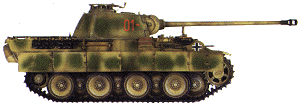


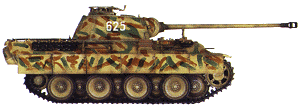



Conclusion:
Overall this is a very sound model of a late Ausf.A with only a few minor issues
as well as others self inflicted by the terrible instructions but thankfully
with the inclusion of a ready spares box most are easily dealt with.
The only real issue is the need to add your own Zimmerit coating to accurately depict the later Ausf.A but other than that a very good model will result.
Highly recommended 8/10
The Sprues:
Click
on thumbnails for larger view










Click Browsers BACK button to return to page
See the Panther Subject page for additional Panther kit and accessory reviews.
References:
The Panther has
been covered in many publications over the years but some earlier references
have information that has been updated in recent books as more accurate information
has come to light.
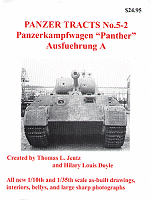 |
Panzer Tracts No.5-2 Panzerkampfwagen "Panther" Ausfuehrung A by Thomas L Jentz and Hilary Louis Doyle ISBN 0-9744862-1-3 Soft cover, 68 pages |
 |
Achtung Panzer No.4 Good photo coverage of the Panther, Japanese text. |
Thanks to my credit card and the excellent service from for
the review kit.
for
the review kit.
Page created March 5, 2007